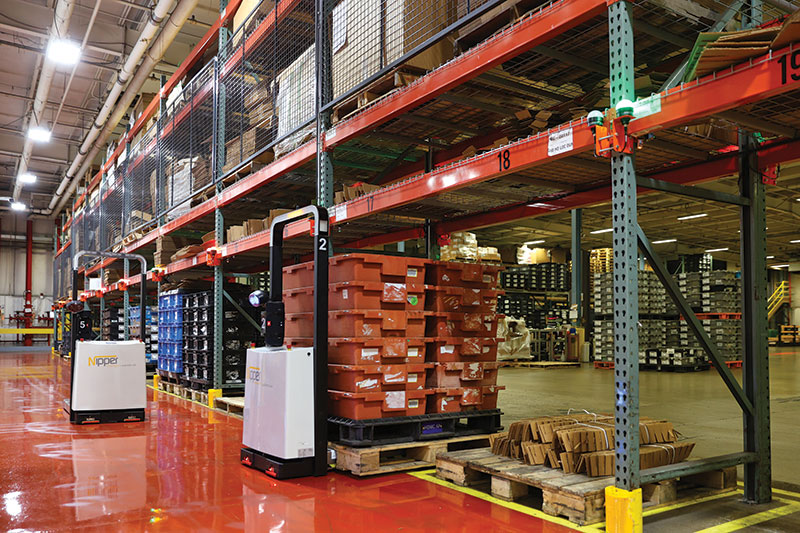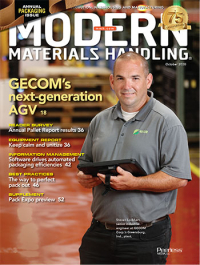GECOM Corp’s next-generation automatic guided vehicles (AGV)
A leading auto parts manufacturer turned to AGVs using next-generation navigation and control technologies to automate lineside delivery and pickup. The result: A 73% reduction in materials handling resources and a two-year ROI.
On the shop floor, manufacturers are constantly dogged by that age-old question. Sure, the plant engineers made the line more efficient last year, but what are they going to do next? After all, the quest to get more efficient never ends. To answer that question, engineering teams are continually looking for new ways—and new technologies—to improve operations, one process at a time.
Get a detailed look at the GECOM distribution center.
That was the position Steven Lockhart, senior industrial engineer at GECOM Corp.’s Greensburg, Ind., plant, found himself in during 2018 when the continuous improvement team was challenged to hit a new human resources number without reducing efficiency.
The process targeted for improvement was the lineside delivery of pallets of empty tubs used to store and transport finished goods and the pickup of full tubs for delivery to a finished goods storage area before they’re shipped to an auto assembly plant or another Tier 1 supplier.
The solution was to replace associates using pallet jacks or driving tuggers and carts with a fleet of five pallet-handling automatic guided vehicles, AGVs, (F3-Design (Nipper)) capable of operating in the facility’s narrow, 8-foot-wide aisles. The AGVs are directed by a next-generation navigation system (Bluebotics) similar to the navigation systems used by autonomous mobile robots (AMRs). It relies on simultaneous location and mapping, or SLAM, to create a digital map of the facility and then uses natural feature navigation for everyday operations rather than magnetic tape or laser guidance more commonly associated with AGVs. The navigation system is tightly integrated with GECOM’s supervisory control and data acquisition systems—a SCADA system—to direct AGV missions. The SCADA system acts like a warehouse management or manufacturing execution system.
The project went live with two AGVs in 2019 and has since been expanded to five vehicles, with the most recent installation in March 2020. The result, says Lockhart, has been a 73% reduction in the manhours allocated to materials handling. “That was our main goal at the start of this project,” Lockhart says. “But, we’ve also been able to create a safer work environment, especially for associates working in the warehouse area who no longer have to be out on the floor.”
Time for AGVs
GECOM Corp. is a subsidiary of Mitsui Kinzoku ACT, a global automotive equipment manufacturer based in Yokohamashi, Japan, and specializing in door-related products. The Indiana plant, currently the only operation in North America, opened in 1987 to manufacture high-quality, door-locking mechanisms for the automotive industry, including door locks, trunk locks, tailgate locks and openers, power sliding door systems, power tailgate systems, seat locks, hinges, checklinks, strikers and trunk openers.
In addition to providing subassemblies to Tier 1 suppliers, the plant ships directly to Honda, Nissan, Toyota, Chrysler, Ford, GM, Subaru and Tesla. The Indiana location currently employs more than 600 associates, operates 105 production lines (65 lines on AGVs) and operates 24 hours a day, five days a week.
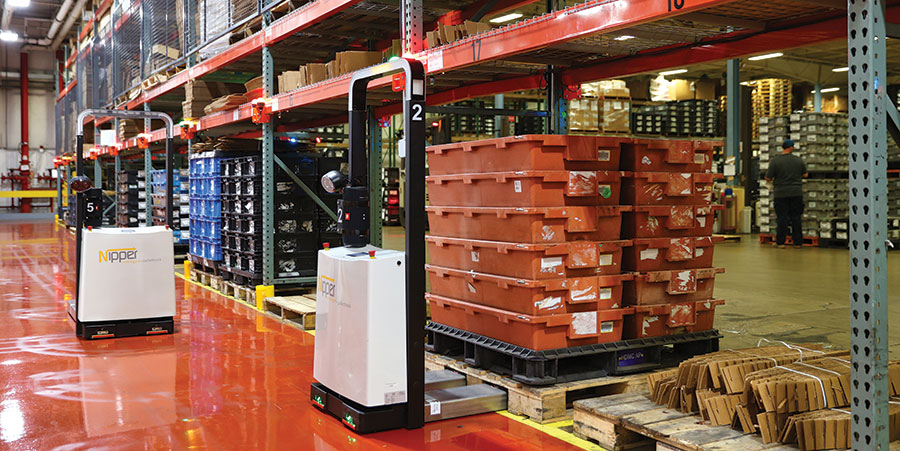
At the start of a mission, an AGV travels to a pickup spot; retrieves a pallet staged for the line and then travels to its destination.
According to Lockhart, the catalyst for the project was a nudge from GECOM’s parent company in 2018 to hit new labor hour targets. The movement of empty tubs and raw materials from the warehouse to the assembly lines and the return of full tubs of finished products to the warehouse was an area the continuous improvement team was already thinking about. Some kind of automated transport using either AGVs or AMRs appeared to be likely candidates and was encouraged by Japan. “Our parent company has had AGVs in place in Japan and the feeling was that it was our turn to bring in that technology,” Lockhart recalls.
The process being replaced was manual. Materials handlers with pallet jacks were responsible for the movement of materials—but it was a 100% visual system. “The materials handlers watched the different lines to decide if they needed tubs,” Lockhart says. “There was often confusion about what line to service next.” He adds that the manual system also resulted in a lot of pedestrian traffic on the floor. Like many manufacturers, reducing pedestrian and lift truck traffic on the floor was a safety priority.
Getting started
The design and implementation of the solution occurred in phases. For phase one, GECOM added a fleet of manually driven tuggers and carts. They not only moved pallets of empty and full tubs, but also brought raw materials from the warehouse to the line.
“Implementing tuggers first allowed us to establish the routes and the pick and drop points before we brought in AGVs,” Lockhart recalls. And, the switch from materials handlers and pallet jacks to one tugger pulling five carts at a time achieved some of the target headcount optimization.
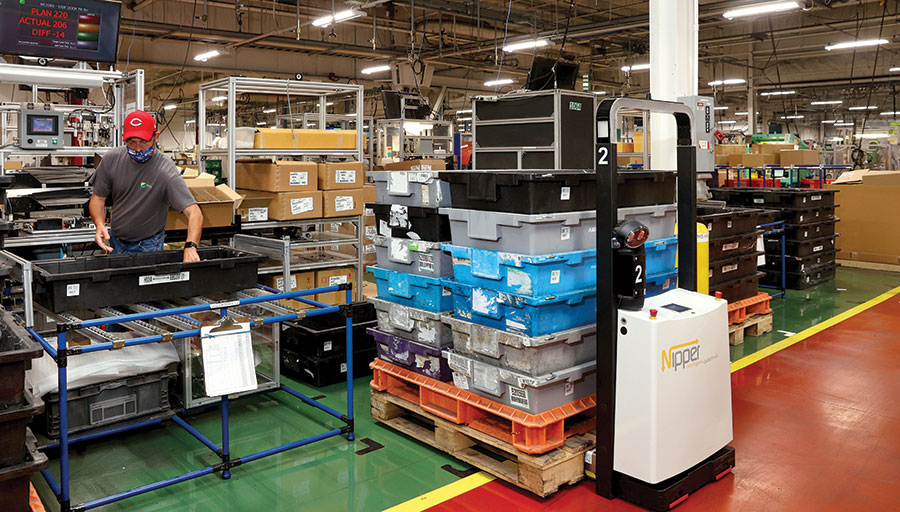
At the assembly line, the AGV retrieves a pallet load of finished goods for storage in the warehouse.
During this phase, however, it became apparent that switching from manual tuggers to a conventional tugger-style AGV could work for moving pallets of raw materials, but it wouldn’t work for moving pallets of tubs of finished goods: The height from the floor to the top of the unit load was too high for associates to stack finished tubs. What’s more, AGVs were too large to work in the plant’s 8-foot-wide aisles.
For several months, the team worked with a supplier of a tugger-style autonomous mobile robots. The AMR had a hook on the back that could latch onto a flat deck cart and then back it into place at an assembly line.
It solved the pallet height problem, but created a safety issue. The AMR didn’t have a rear scanner that could detect an individual in its path when it backed the cart into place. “There was no safety stop once the reverse sequence started and the vehicle was backing up,” he says. “At GECOM, safety is always a top priority when investigating any new technology.”
That spring, Lockhart saw a video for the AGV currently in use. “Once I watched what it could do for its size, I knew we needed to pursue it,” he remembers. In November of 2018, a team from GECOM went to the Netherlands to see the AGVs in operation. Lockhart says the team was impressed by several factors: the AGV’s 2,200-pound payload and a 4- to 5-hour run time on a 30-minute charge. Perhaps topping the list was the natural feature navigation system, which would require minimal infrastructure changes beyond a few adhesive reflectors. This type of navigation was more common in AMRs than AGVs. “I knew I didn’t want a system that follows tape,” he says. “Our vehicles run off data from a 360-degree navigation scanner and use Wi-Fi to communicate.”
Lockhart says his team decided to jump off the deep end and purchase two vehicles to get started with AGVs.
Design and implement
Now that the continuous improvement team had settled on the solution and technology, the design and implementation process came next. The first step was working with a local system integrator to digitize the visualization process by getting tablets in the hands of supervisors and integrate a SCADA software system with the AGV navigation system. With tablets, the team leaders were mobile, rather than tied to a desktop computer. The tablets could be used for other things, like scanning parts for lot control so GECOM has a record of what batch of parts was used on what day. Tablets were also distributed to associates who were still working on the floor as substitute AGVs while the AGV solution was being designed.
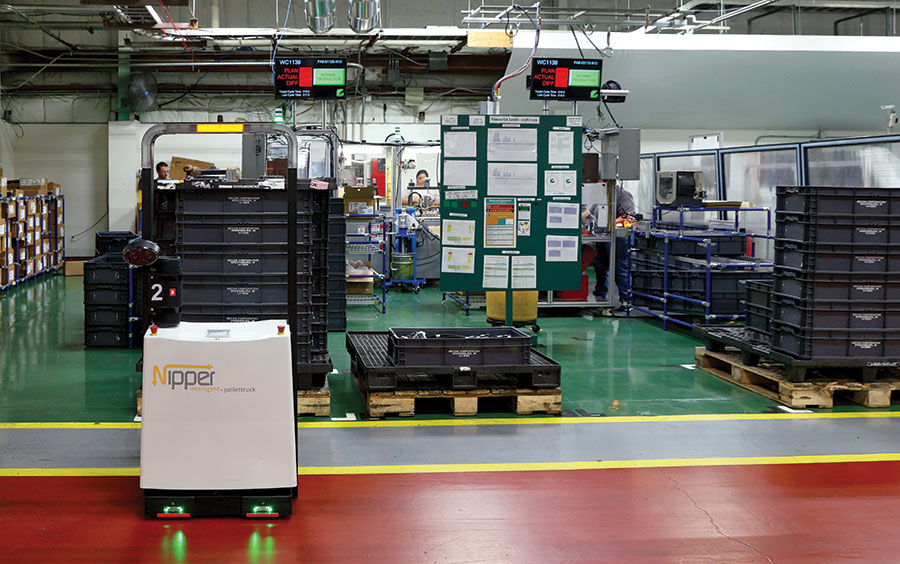
The pallet is dropped off at a staging area in the warehouse. Red, yellow and green lights alert warehouse workers to the status of the drop-off locations.
“Typically, we have 13 team leaders on the first shift, so I could assign five production lines to a team leader,” Lockhart says. “Using the tablets, they could log into their lines and decide whether to deliver a pallet of empty tubs to a line or pick up a full pallet.” The system could also alert materials handlers when they had tasks. While the AGVs have since replaced materials handlers, tablets are now used to assign tasks to warehouse workers who interface with the AGVs. “We realized we were bringing in new technology and wanted to get comfortable with the system before the AGVs showed up,” Lockhart says.
Concurrent with the tablet project, the team began working with the navigation software system and server. Using AutoCAD drawings for the floor layout, they learned how to do mapping and identify pickup and drop-off points in the system before bringing in the vehicles. In addition, the system enabled GECOM to run simulations to calculate trip times, how long it would take to get to and from various points and simulate how the traffic control function would work if two AGVs came to the same intersection at the same time.
The first two AGVs were delivered in March 2019 and took about two weeks to implement. “By the time the AGVs arrived, we had all been working on the software on tablets and our laptops and were comfortable with it,” Lockhart says. “It only took a couple of weeks to run some trials.”
The first step after setting up the AGVs was to delete the AutoCAD map and create a digital map using the laser scanner on the AGV. During the mapping process, the AGV is operated in manual mode, using a joy stick to drive it. During mapping, the system uses the 360-degree scanner and SLAM technology to create the map.
Since machinery is moved often, GECOM installed 3-foot-long poles that were 3-inches in diameter in the aisles as permanent reference points. “When you start mapping, the system scans everything, but we were able to go back in and delete anything that we didn’t want to use a reference,” Lockhart says. “That way if we moved a line to a new location, we didn’t have to update the map.”
Once the mapping was complete, they began running trial missions and calculating how big a fleet they would need at full production—the initial estimate was six vehicles. “We were very cautious with our approach, and it probably took two to three months to feel comfortable that our drop and pickup points were in the right places,” Lockhart says.
After working with the first two vehicles for four months, the next two vehicles went live in September 2019. There were plans to implement two more in early 2020, but after working with the vehicles and software, GECOM realized they could get the job done with five.
Lockhart says there were hiccups along the way, such as errant error codes, but the AGVs ran with no major downtimes during the learning curve. “All the homework we did up front paid off,” he says.
Still, that “What have you done for me lately?” question will be out there. Lockhart notes that GECOM is looking at ways to expand the use of AGVs in the facility. That could include a high reach truck for the warehouse, and replacing the manual tuggers that are still used to bring raw components to the assembly lines with AGVs. “It’s definitely been a successful project,” he adds. “We’ve made our target headcount reduction, delivered a two-year ROI and are exploring other AGV possibilities.”

Article Topics
AGVs and AMRs News & Resources
2024 Intralogistics Robotics Survey: Robot demand surges Autonomous mobile robots (AMRs) on a mission K.Hartwall and its Australian distribution partner, Retailquip, join forces Pramac partners with BlueBotics to launch line of ANT driven mobile robots Mitsubishi Logisnext partners with Jungheinrich to introduce Rocrich AGV Solutions CaPow’s power-in-motion solution eliminates charging downtime Conveyco unveils All-Temp AMRs that can move between frozen, chilled and ambient warehouses More AGVs and AMRsLatest in Materials Handling
Geek+ and System Teknik deploy PopPick solution for pharmacy group Med24.dk Beckhoff USA opens new office in Austin, Texas Manhattan Associates selects TeamViewer as partner for warehouse vision picking ASME Foundation wins grant for technical workforce development The (Not So) Secret Weapons: How Key Cabinets and Asset Management Lockers Are Changing Supply Chain Operations MODEX C-Suite Interview with Harold Vanasse: The perfect blend of automation and sustainability Consultant and industry leader John M. Hill passes on at age 86 More Materials HandlingAbout the Author
Subscribe to Materials Handling Magazine

Find out what the world's most innovative companies are doing to improve productivity in their plants and distribution centers.
Start your FREE subscription today.
April 2024 Modern Materials Handling

Latest Resources


